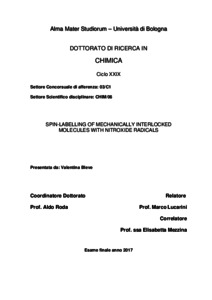Bleve, Valentina
(2017)
Spin-Labelling of Mechanically Interlocked Molecules with Nitroxide Radicals, [Dissertation thesis], Alma Mater Studiorum Università di Bologna.
Dottorato di ricerca in
Chimica, 29 Ciclo. DOI 10.6092/unibo/amsdottorato/7921.
Documenti full-text disponibili:
![[img]](http://amsdottorato.unibo.it/7921/7.hassmallThumbnailVersion/Bleve_Valentina_tesi.pdf)  Anteprima |
|
Documento PDF (English)
- Richiede un lettore di PDF come Xpdf o Adobe Acrobat Reader
Disponibile con Licenza: Salvo eventuali più ampie autorizzazioni dell'autore, la tesi può essere liberamente consultata e può essere effettuato il salvataggio e la stampa di una copia per fini strettamente personali di studio, di ricerca e di insegnamento, con espresso divieto di qualunque utilizzo direttamente o indirettamente commerciale. Ogni altro diritto sul materiale è riservato.
Download (6MB)
| Anteprima
|
Abstract
Molecular machines, namely assemblies of a distinct number of molecular components that are designed to perform machine like movements (output) as a result of an appropriate external stimulation (input) in order to accomplish a specific function, have been described in the recent years, with possible utility in the field of information and communication technology (ICT), materials science, catalysis, and medicine. The first step towards the design of artificial molecular machines is represented by molecular shuttles, namely [2]rotaxanes, in which the ring component can be displaced between two non-equivalent locations on the axle component by appropriate stimuli. The characterization of these systems, depending on the nature and chemical properties of their molecular components, is typically carried out by high-resolution X ray crystallography, nuclear magnetic resonance (NMR) spectroscopy, electrochemical and photophysical techniques. As an alternative, electron paramagnetic resonance (EPR) spectroscopy can be useful to investigate these systems because offers different advantages. However, in order to use EPR spectroscopy, organic radicals, such as nitroxides, must be introduced in the system. The aim of my project was devoted to prepare and investigate bistable [2]rotaxanes, containing nitroxide units to exploit EPR spectroscopy for their characterization. In Chapter 1 a brief overview of the principal concepts of rotaxane, the spin labelling approach and the employment of ESR and PELDOR (Pulsed electron electron double resonance) methods applied to paramagnetic systems are described. Chapter 2, 3 and 4 are focused on the synthesis and characterization of a series of bistable [2]rotaxanes driven by chemical and electrochemical stimuli. The introduction of nitroxide units in these systems allows both to monitorate the macrocycle movement by using EPR spectroscopy and to understand in detail the structural and conformational changes occurring after the movement of their molecular components by performing PELDOR technique.
Abstract
Molecular machines, namely assemblies of a distinct number of molecular components that are designed to perform machine like movements (output) as a result of an appropriate external stimulation (input) in order to accomplish a specific function, have been described in the recent years, with possible utility in the field of information and communication technology (ICT), materials science, catalysis, and medicine. The first step towards the design of artificial molecular machines is represented by molecular shuttles, namely [2]rotaxanes, in which the ring component can be displaced between two non-equivalent locations on the axle component by appropriate stimuli. The characterization of these systems, depending on the nature and chemical properties of their molecular components, is typically carried out by high-resolution X ray crystallography, nuclear magnetic resonance (NMR) spectroscopy, electrochemical and photophysical techniques. As an alternative, electron paramagnetic resonance (EPR) spectroscopy can be useful to investigate these systems because offers different advantages. However, in order to use EPR spectroscopy, organic radicals, such as nitroxides, must be introduced in the system. The aim of my project was devoted to prepare and investigate bistable [2]rotaxanes, containing nitroxide units to exploit EPR spectroscopy for their characterization. In Chapter 1 a brief overview of the principal concepts of rotaxane, the spin labelling approach and the employment of ESR and PELDOR (Pulsed electron electron double resonance) methods applied to paramagnetic systems are described. Chapter 2, 3 and 4 are focused on the synthesis and characterization of a series of bistable [2]rotaxanes driven by chemical and electrochemical stimuli. The introduction of nitroxide units in these systems allows both to monitorate the macrocycle movement by using EPR spectroscopy and to understand in detail the structural and conformational changes occurring after the movement of their molecular components by performing PELDOR technique.
Tipologia del documento
Tesi di dottorato
Autore
Bleve, Valentina
Supervisore
Co-supervisore
Dottorato di ricerca
Ciclo
29
Coordinatore
Settore disciplinare
Settore concorsuale
Parole chiave
EPR PELDOR rotaxane spin labelling supramolecular chemistry
URN:NBN
DOI
10.6092/unibo/amsdottorato/7921
Data di discussione
19 Aprile 2017
URI
Altri metadati
Tipologia del documento
Tesi di dottorato
Autore
Bleve, Valentina
Supervisore
Co-supervisore
Dottorato di ricerca
Ciclo
29
Coordinatore
Settore disciplinare
Settore concorsuale
Parole chiave
EPR PELDOR rotaxane spin labelling supramolecular chemistry
URN:NBN
DOI
10.6092/unibo/amsdottorato/7921
Data di discussione
19 Aprile 2017
URI
Statistica sui download
Gestione del documento:


 Login
Login
